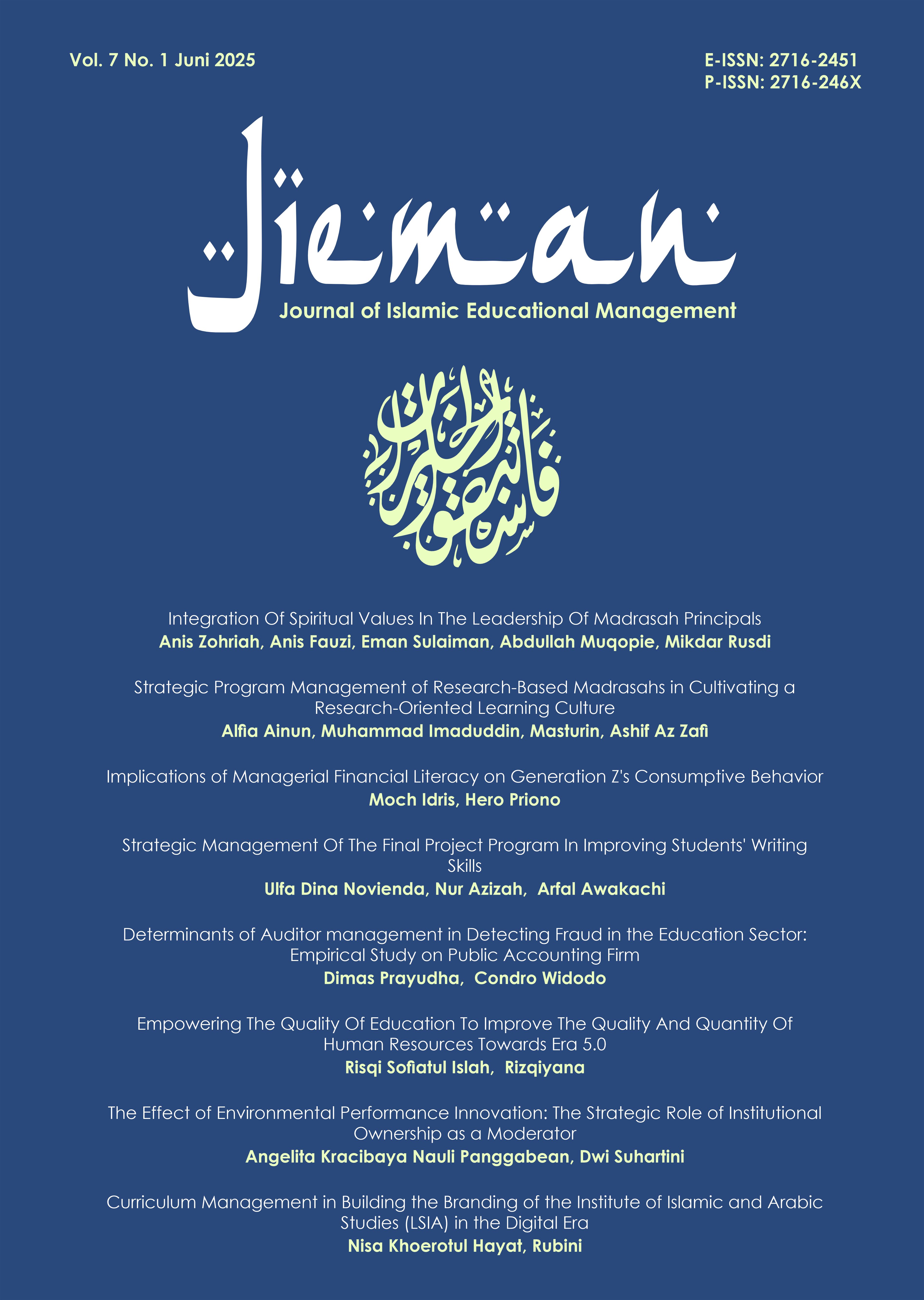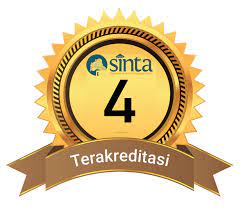Empowering The Quality Of Education To Improve The Quality And Quantity Of Human Resources Towards Era 5.0
DOI:
https://doi.org/10.35719/jieman.v7i1.228Keywords:
Empowerment,, Human Resource Development, Society 5.0Abstract
The quality of education in preparing human resources to face Era 5.0, not only demands technological competence, but also high adaptability in responding to digital and industrial transformation. This research integrates literature analysis with a Qualitative approach with a type of direct study involving educational institutions that have initiated innovations in learning approaches and curriculum development. Data was collected through in-depth interviews with teachers, students as well as through observation and documentation. The study revealed that several key elements play an important role in improving the quality of education, including adaptive curriculum development, continuous professional development for educators, integration of educational technology, and active collaboration between educational institutions and local industries. These efforts are not only instrumental in improving learning outcomes, but are also crucial in aligning education with industry needs. In addition, the findings emphasize the importance of adopting a holistic education framework that bridges the formal and non-formal education sectors while encouraging the active involvement of various stakeholders. The results of this research are critical to producing competent, innovative and future-ready individuals who are able to face the dynamic challenges of Era 5.0.
References
Ambarwati, A. (2018). Perilaku Dan Teori Organisasi. Media Nusa Creative. https://www.researchgate.net/publication/324645855_Perilaku_Dan_Teori_Organisasi
Arikunto, S. (2013). Prosedur Penelitian Suatu Pendekatan Praktik. PT. Rineka Cipta. https://inlislite.ipdn.ac.id/opac/detail-opac?id=8242
Baderiah. (2018). Buku Ajar Pengembangan Kurikulum. Lembaga Penerbit Kampus IAIN Palopo. https://repository.iainpalopo.ac.id/id/eprint/308/
Capuano, N., & Caballé, S. (2020). Adaptive learning technologies. AI in Education Column, 97–104. http://dx.doi.org/10.1609/aimag.v41i2.5317
Contrino, M. F., Reyes Millán, M., & Vázquez Villegas, P. (2024). Using an adaptive learning tool to improve student performance and satisfaction. Smart Learning Environments, 11(6). https://doi.org/10.1186/s40561-024-00292-y
Creswell, J. W. (2014). Research design: Qualitative, quantitative, and mixed methods approaches (4th ed.). Thousand Oaks, CA: SAGE Publications https://spada.uns.ac.id/pluginfile.php/510378/mod_resource/content/1/creswell.pdf
El Sabagh, M., & Hamed, M. (2021). Adaptive e learning environment based on students’ learning styles. International Journal of Educational Technology in Higher Education, 18. https://doi.org/10.1186/s41239-021-00289-4
Fakir, M. S. B., Azman, H. A. B., & Zahid, A. Z. B. M. (2024). Exploring Online Group Work through Connectivism Theory. International Journal of Academic Research in Business and Social Sciences, 14(8), 2556–2569. https://doi.org/10.6007/IJARBSS/v14-i8/21945
Gransden, C., Hindmarsh, M., Lê, N. C., & Nguyen, T.-H. (2024). Adaptive learning through technology: a technical review and implementation. Higher Education, Skills and Work-Based Learning, 14(2), 409–417. https://doi.org/10.1108/HESWBL 05 2023 0121
Husnan, Riayatul, Rofiq Hidayat, and Machfudz. (2023). “Manajemen Konflik Madrasah Pasca Pandemi Covid- 19 Di Wilayah Tapal Kuda”. Re-JIEM (Research Journal of Islamic Education Management) 6 (1), 74-85. https://doi.org/10.19105/re-jiem.v6i1.8587.
Ismail, M. I. (2020). Evaluasi Pembelajaran: Konsep Dasar, Prinsip, Teknik, dan Prosedur. Raja grafindo Persada. https://repository.unissula.ac.id/22627/10/DAFTAR%20PUSTAKA.pdf
Kurniawan, H., & Hasanah, E. (2021). Peran Kepala Sekolah dalam Meningkatkan Inovasi dan Kreativitas Guru pada Masa Pandemi di SD Muhammadiyah Bantul Kota. Jurnal Studi Guru Dan Pembelajaran, 4(1), 56–66. https://doi.org/10.30605/jsgp.4.1.2021.476
Kusumawati, K. (2023). Pemanfaatan Teknologi Informasi dalam Pendidikan. Jurnal Limits, 5(1), 7–14. https://doi.org/10.59134/jlmt.v5i1.311
Martin, M. (2023). The Advantages and Disadvantages of Online Classes. Thinkific. https://www.thinkific.com/blog/advantages-and-disadvantagesonline-classes/
Muhasim. (2017). Pengaruh Teknologi Digital terhadap Motivasi Belajar Peserta Didik. PALAPA, 5(2), 268–273. https://doi.org/10.36088/palapa.v5i2.46
Mukhlis, H., Haenilah, E. Y., Sunyono, et al. (2024). Connectivism and digital age education: Insights, challenges, and future directions. Kasetsart Journal of Social Sciences, 45(3), 803–814. https://doi.org/10.44217/kjss.2024.803
Siemens, G. (2005). Connectivism: A learning theory for the digital age. International Journal of Instructional Technology & Distance Learning, 2(1), 3–10. https://www.scirp.org/reference/referencespapers?referenceid=148504
Simon, P. D., & Zeng, L. M. (2024). Behind the scenes of adaptive learning: A scoping review of teachers’ perspectives. Education Sciences, 14(12), 1413. https://doi.org/10.3390/educsci14121413
Slamet. (2022). Peran Kepala Sekolah dalam Membangun Citra Publik pada Era 5.0. DIAJAR: Jurnal Pendidikan dan Pembelajaran, 1(3), 268–273. https://doi.org/10.54259/diajar.v1i3.963
Widodo, H. (2019). Kepemimpinan Kepala Sekolah Perempuan. Pedagogia: Jurnal Pendidikan, 8(1), 127–137. https://doi.org/10.21070/pedagogia.v8i1.1871
Xie, H., Chu, H. C., Hwang, G. J., & Wang, C. C. (2019). Trends and development in technology-enhanced adaptive/personalized learning. Computers & Education, 140, 103599. https://doi.org/10.1016/j.compedu.2019.103599
Xu, C. (2021). Thoughts on the Implementation of Online and Offline Hybrid Teaching of University Computer Courses. Region - Educational Research and Reviews, 3(2), 1–4. https://doi.org/10.32629/rerr.v3i2.291
Downloads
Published
How to Cite
Issue
Section
License
Copyright (c) 2025 Risqi Sofiatul Islah, Rizqiyana

This work is licensed under a Creative Commons Attribution-ShareAlike 4.0 International License.







